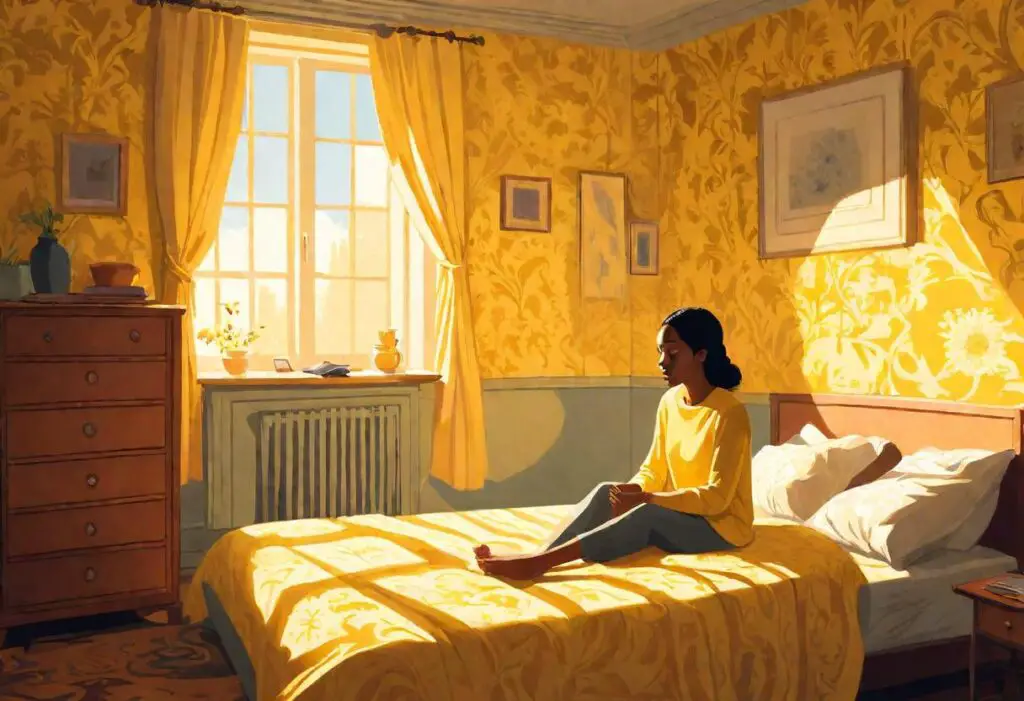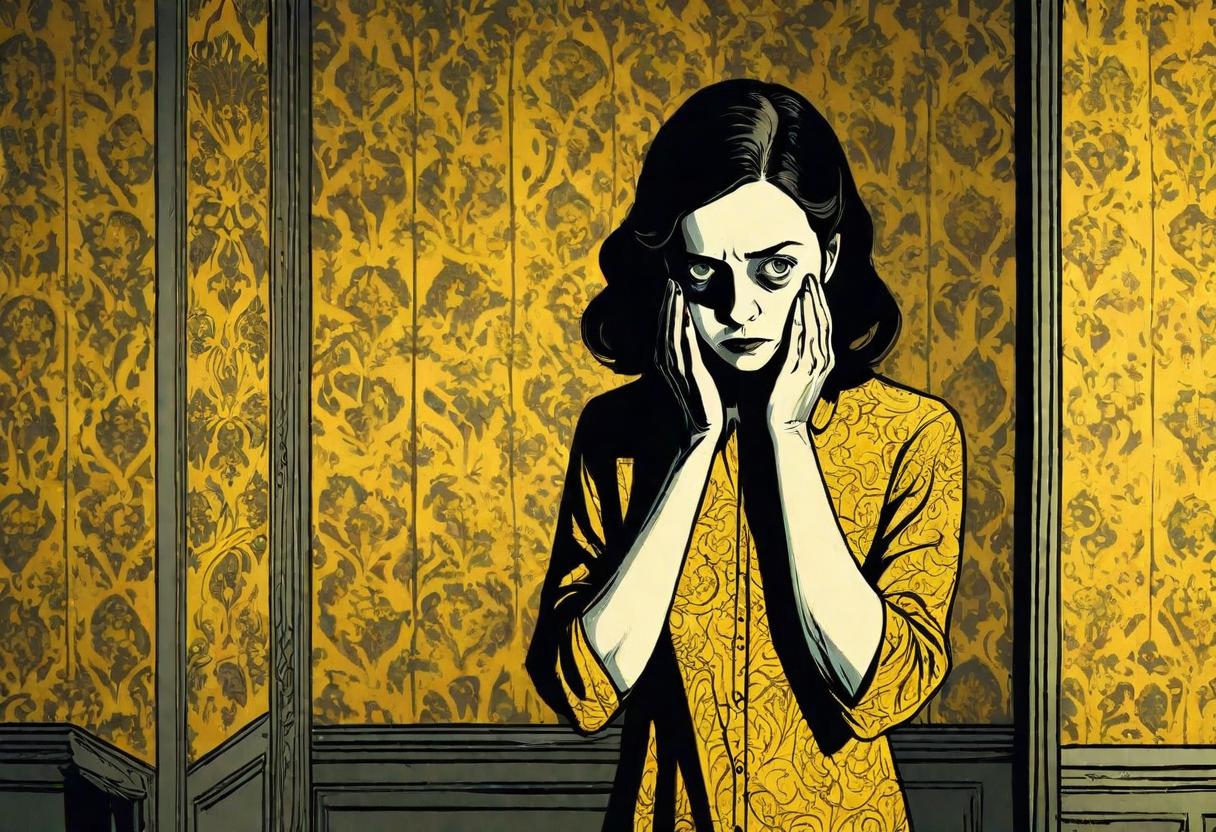“The Yellow Wallpaper” by Charlotte Perkins Gilman is a short story that talks about mental health. It focuses on anxiety and depression. Through the main character’s journey, Gilman shows how these feelings can come from our own minds. She also shows that we can control these feelings by changing how we think. This article will explain these ideas in simple terms and give tips on handling mental health.
The Story of “The Yellow Wallpaper”:
“The Yellow Wallpaper” is about a woman named Jane who feels sad after having a baby. Her husband, John, is a doctor. He tells her she needs to rest and avoid anything that makes her think or feel too much. John rents a big house in the countryside for the summer and puts Jane in a room with yellow wallpaper that she dislikes.

John believes staying in this room will help Jane get better. He does not let her write, work, or do anything creative. He even tells her not to think too much. Jane feels lonely and trapped because she has nothing to do and no one to talk to. She spends a lot of time looking at the yellow wallpaper.
As days go by, Jane becomes more obsessed with the wallpaper. She starts to see strange patterns and believes there are women trapped inside it. Jane thinks she needs to help them escape.
She spends all her time staring at the wallpaper and trying to free the trapped women. Jane stopped eating and sleeping properly because she was so focused on it. Her mind begins to play tricks on her, making her confused.
Jane’s obsession shows how she feels trapped in her life. She feels controlled by her husband and by society’s expectations. In the end, Jane loses her mind completely. She believes she is one of the women in the wallpaper. She tears it off the walls, thinking she is setting herself free. When John seeshe is shocked and faints. Jane creeps around, feeling she has finally escaped her mental prison.
Our thoughts have a big impact on how we feel. In “The Yellow Wallpaper,” the main character’s thoughts become more and more obsessed and scared, making her anxiety and depression worse. This shows how negative thoughts can make us feel bad and keep us feeling that way.
Negative thoughts can make us feel stuck in a loop of bad feelings. The main character’s focus on the wallpaper shows how our minds can trap us in these thoughts. Knowing that our thoughts can do this is the first step to changing them.
Anxiety: A Feeling from Our Minds:
Anxiety often comes from our thoughts and how we see things. In the story, the main character’s anxiety gets worse because she is alone and doesn’t like the yellow wallpaper. She thinks the wallpaper is alive and scary, which makes her more anxious. This shows that changing our surroundings and thoughts can help with anxiety.
Anxiety can make us worry about things that may not be as bad as we think. By understanding that these feelings come from our minds, we can start to question them and think more positively.
1. Challenge Negative Thoughts
When you notice anxious thoughts, take a moment to question them. Ask yourself:
- Is this thought based on facts?
- What evidence do I have that supports or contradicts this thought?
- Could there be a different, more positive way to view this situation?
By actively challenging negative thoughts, you can begin to reshape your thinking and reduce anxiety.
2. Change Your Environment
If possible, change your surroundings. Spend time outdoors, engage in physical activity, or find a comfortable and calming space. A new environment can help refresh your mind and provide a different perspective. Activities like walking, playing a sport, or simply enjoying nature can significantly improve your mood and reduce feelings of anxiety.
3. Practice Mindfulness and Relaxation Techniques
Incorporate mindfulness practices into your routine. This could include:
- Deep breathing exercises
- Meditation
- Yoga
Mindfulness helps you stay present and can reduce the tendency to overthink or worry about the future. Taking a few moments each day to focus on your breath or engage in a calming activity can create a sense of peace and help manage anxiety.
By using these strategies, you can better understand and control your anxiety, leading to improved mental well-being.
Depression: A Battle Inside
Depression is also a battle that happens inside our minds. The main character feels more and more sad because she feels powerless and ignored. Her thoughts get darker, showing how depression can grow from our negative thoughts. She feels trapped by her husband’s control and her treatment, just like she feels trapped by the wallpaper.
Depression can make us feel like we can’t escape our own sad thoughts. The story shows the need to understand and deal with these feelings to get better.
Being Alone Can Make Things Worse:
Being alone can make anxiety and depression worse. The main character’s forced isolation makes her mental health get worse. Not having people to talk to or things to do makes her focus on the wallpaper and lose her mind. This shows that social interaction and staying busy are important for mental health.
Being alone takes away the support and activities we need to feel good. It can make us feel lonely and sad. The story reminds us that we need a balanced approach to mental health, which includes being with others and staying active.
The Power of Changing How We Think:
Changing our thoughts can help a lot with mental health. Cognitive-behavioral therapy (CBT) is a method that helps people change negative thoughts. In the story, the main character can’t change her thoughts, which leads to her downfall.
CBT techniques like challenging negative thoughts, practicing mindfulness, and developing healthier thinking habits can help manage anxiety and depression. By learning to see and change negative thought patterns, we can gain greater control over our mental health.
Tips to Apply CBT for Better Mental Health:
1. Challenge Negative Thoughts
- Identify Triggers: Note when negative thoughts occur and their triggers.
- Question Them: Ask if the thought is true and what evidence supports it.
2. Practice Mindfulness
- Breathing Exercises: Focus on your breath to stay present.
- Body Scans: Check in with your body to increase awareness.
3. Develop Healthier Thinking
- Positive Affirmations: Repeat positive statements about yourself.
- Gratitude Journal: List three things you’re grateful for each day.
4. Behavioral Activation
- Set Small Goals: Start with manageable tasks to boost mood.
- Schedule Activities: Plan enjoyable activities to stay engaged.
5. Seek Support
- Talk to Someone: Share feelings with a friend or therapist.
- Join a Support Group: Connect with others for shared experiences.
The Importance of a Supportive Environment:
A supportive environment is crucial for mental health. The protagonist’s lack of support and understanding from her husband and society contributes to her deteriorating mental state. John dismisses her feelings and thoughts, insisting that he knows what is best for her. This highlights the need for empathy and support in managing anxiety and depression.
Support from loved ones, friends, and mental health professionals can provide the encouragement and understanding needed to navigate mental health challenges. A supportive environment fosters a sense of safety and acceptance, which is essential for recovery.
The Symbolism of the Yellow Wallpaper:
The yellow wallpaper symbolizes the protagonist’s mental state and societal oppression. Her obsession with the wallpaper reflects her struggle with her thoughts and the limits imposed on her. As she projects her feelings of capture and frustration onto the wallpaper, it becomes a mirror of her inner turmoil.
The wallpaper’s complex and wild pattern represents the complexity and confusion of the protagonist’s mind. The trapped women she sees in the wallpaper symbolize her own entrapment by societal norms and the restrictive treatment prescribed by her husband. Understanding this symbolism can offer insights into how our environment and thoughts interact.
Lessons from “The Yellow Wallpaper” for Modern Mental Health:
“The Yellow Wallpaper” offers valuable lessons for modern mental health. It emphasizes the importance of recognizing and addressing negative thought patterns, seeking support, and creating a conducive environment for mental well-being.
Strategies for Managing Anxiety and Depression:
Mindfulness and Meditation: Practicing mindfulness and meditation can help manage negative thoughts and reduce anxiety and depression. These techniques encourage present-moment awareness and non-judgmental acceptance of thoughts and feelings.
Cognitive-Behavioral Therapy (CBT): CBT helps change negative thoughts into positive ones. It teaches you to spot negative thinking and challenge it. Then, you replace those thoughts with healthier, more realistic ideas. This can improve your mental health.
Social Support: Engaging with supportive friends and family can provide emotional relief and reduce feelings of isolation. Social connections offer a sense of belonging and can provide practical and emotional support.
Physical Activity: Regular exercise can boost mood and alleviate symptoms of anxiety and depression. Physical activity releases endorphins, which are natural mood lifters, and can provide a sense of accomplishment.
Healthy Lifestyle Choices: Maintaining a balanced diet, regular sleep, and avoiding alcohol and drugs can improve overall mental health. Good nutrition, adequate sleep, and avoiding harmful substances contribute to physical and mental well-being.
Conclusion: The Power of Our Minds
“The Yellow Wallpaper” serves as a poignant reminder of the power of our minds in shaping our mental health. By changing our thought patterns and creating a supportive environment, we can manage and even overcome anxiety and depression.
The story underscores the importance of addressing mental health with empathy, understanding, and proactive strategies. Recognizing the role of our thoughts and environment in mental health can empower us to take control and seek the help we need to live healthier, more fulfilling lives.
